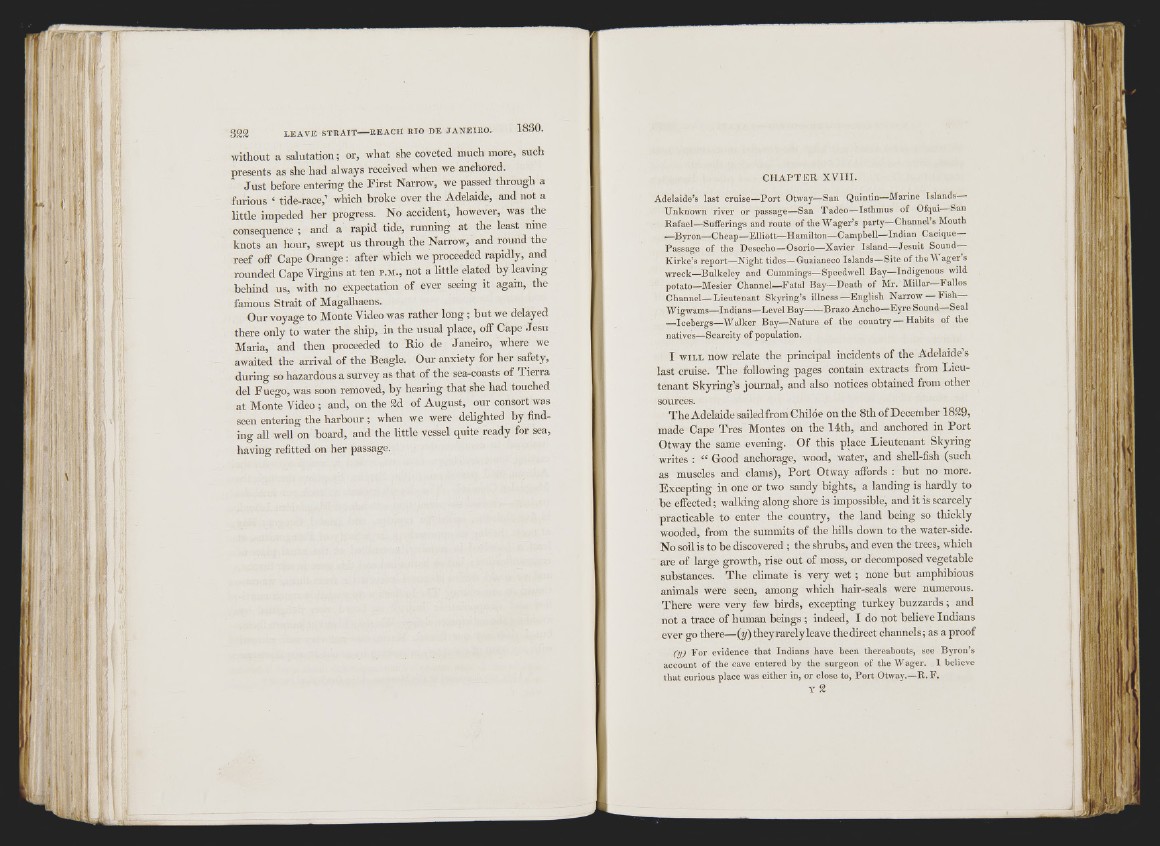
A (
■ d
i J
i! I
■.V' 4
I in-
I I
t |!
f,
n ito i
(' n n ¡ I
without a salutation; or, what she coveted much more, such
presents as she had always received when we anchored.
Just before entering the First Narrow, we passed through a
furious ‘ tide-race,’ which broke over the Adelaide, and not a
little impeded her progress. No accident, however, was Oie
consequence ; and a rapid tide, running at the least nine
knots an liour, swept us through the Narrow, and round the
reef off Cape Orange : after which we proceeded rapidly, and
rounded Cape Virgins at ten p .m ., not a little elated by leaving
behind us, with no expectation of ever seeing it again, the
famous Strait of Magalhaens.
Our voyage to Monte Video was rather long ; but we delayed
there only to water the ship, in the usual place, off Cape Jesu
Maria, and then proceeded to Rio de Janeiro, where we
awaited the arrival of the Beagle. Our anxiety for her safety,
during so hazardous a survey as that of the sea-coasts of Tierra
del Fuego, was soon removed, by hearing that she had touched
at Monte Video ; and, on the 2d of August, our consort was
seen entering the harbour ; when we were delighted hy find-
ino- all well on board, and the little vessel quite ready for sea,
having refitted on her passage.
C H A P T E R X V I I I .
Adelaide’s last cruise—P o rt Otway—San Quintin—Marine Islands
Unknown river or passage—San Tad eo—Isthmus of Ofqui San
Rafael—Sufferings and route of the W ag e r’s party—Channel’s Mouth
'—Byron—Cheap—Elliott—Hamilton—Campbell—Indian Cacique
Passage of the Desecho—Osorio—Xavier Island—Jesuit Sound
K irk e ’s rep o rt—Night tides—Guaianeco Islands—Site of the VI ager’s
wreck—Bulkeley and Cummings—Speedwell Bay—Indigenous wild
potato—Mesier Channel—Fatal Bay—Death of Mr. Millar—Fallos
Channel— Lieutenant Skyring’s illn e ss—English Narrow — F ish
Wigwams—Indians—Level Bay-------Brazo Ancho—Eyre Sound Seal
—Icebergs—Walker Bay—Nature of the c o u n t r y — Habits of the
natives—Scarcity of population.
I W I L L now relate the principal incidents of the Adelaide’s
last cruise. The following pages contain extracts from Lieutenant
Skyring’s journal, and also notices obtained from other
sources.
The Adelaide sailedfrom Chilóe on the 8th of December 1829,
made Cape Tres Montes on the 14th, and anchored in Port
Otway the same evening. Of this place Lieutenant Skyring
writes : “ Good anchorage, wood, water, and shell-fish (such
as muscles and clams). Port Otway affords : hut no more.
Excepting in one or two sandy bights, a landing is hardly to
be effected; walking along shore is impossible, and it is scarcely
practicable to enter the country, the land being so thickly
wooded, from the summits of the hills down to the water-side.
No soil is to be discovered ; the shrubs, and even the trees, which
are of large growth, rise out of moss, or decomposed vegetable
substances. The climate is very wet ; none but amphibious
animals were seen, among which hair-seals were numerous.
There were very few birds, excepting turkey buzzards; and
not a trace of human beings ; indeed, I do not believe Indians
ever go there—(y) theyrarelyleave thedirect channels; as a proof
CyJ F o r evidence tha t Indians have been thereabouts, see Byron’s
account of the cave entered by the surgeon of the Wager. I believe
th a t curious place was either in, or close to, P o rt Otway.—R . F .
Y 2
j* '
m
j |
11
liil